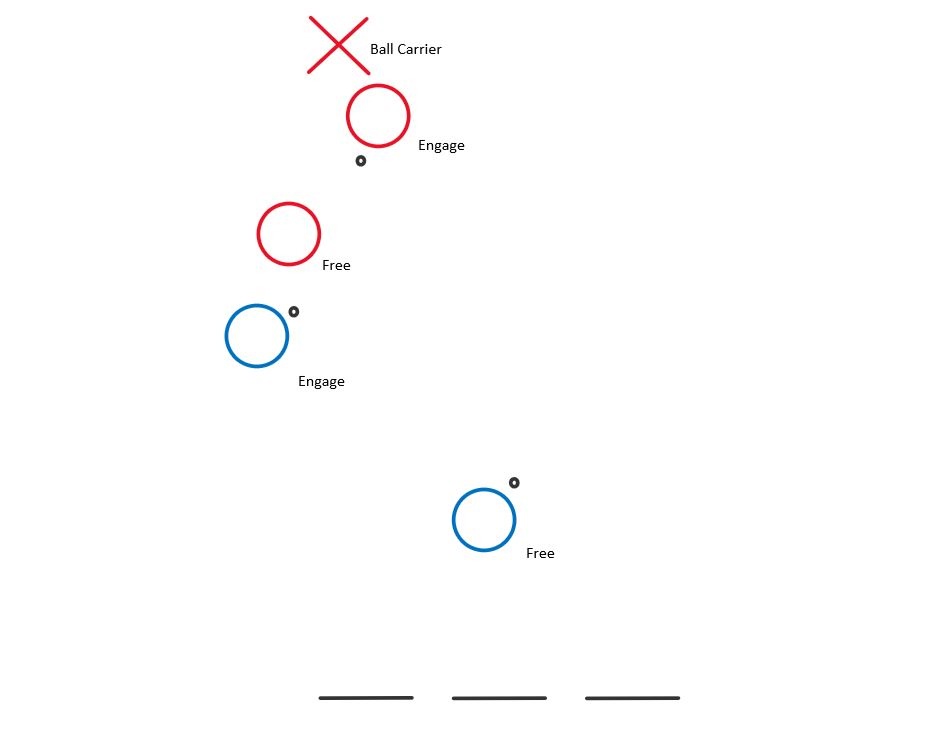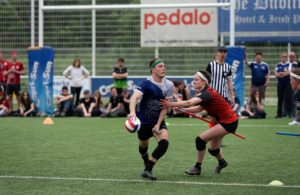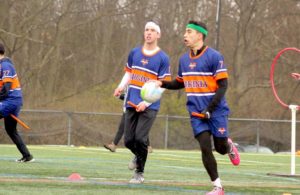- Rule, Britannia, no more?
- Unpopular Opinions: US Quadball Cup 2023
- Proven Contenders: University of Virginia
- Proven Contenders: Rutgers University
- Proven Contenders: University of Michigan
- Proven Contenders: Creighton University
- Different Perspectives: A Look Inside USA Ultimate
- Antwerp QC, Much of Belgian Core, Leaves Competitive Quidditch
Guest Article: Female Beaters in Quidditch
By Fiona Wisehart, Guest Writer
Editor’s Note: This article does not include a discussion of gender non-conforming athletes, as the author did not feel qualified to speak to such. However, The Eighth Man would welcome the opportunity to publish a similar article about gender non-conforming players. Contact editors@eighthman.com if you are interested.
The Role of Beaters in Quidditch
For most teams, the beater position is the most versatile on the field. They interact with other beaters, quaffle players, and seekers and have specific jobs relating to each. A beater’s main task is to help their quaffle players achieve a favorable point differential by helping their quaffle players score goals on offense and preventing the opposing team from scoring on defense. When the seeker floor ends, beaters gain the additional task of helping their seeker catch the snitch and prevent the opposing team’s seeker from catching the snitch. One of the main ways they accomplish these tasks is by dueling opposing beaters and maintaining bludger control.
The Engage Beater vs the Free Beater
Most successful beater plays require a balance between an ‘engage beater’ and a ‘free beater.’ The players that are filling these roles can change during a game, but most players prefer one or the other. Although this terminology has been recently coined, this division of labor is the current standard. It was first used in the Midline video Beating 101: Playing with One Bludger by Lulu Xu and Max Havlin.
The engage beater is primarily a beater-on-beater role. They accomplish the tasks described above by applying high pressure to force the opposing team into making mistakes and initiate beater duels. To do this, they rely on a particular skill set which includes having a strong throw and strong dueling skills (blocking, catching, and dodging). Historically, when on defense with control, the engage beater will play the front position (see Fig.1). Some teams now use a side-side formation, but will still have both an engage and free beater. In this formation, the engage beater is on the strong side. On offense, their position is not as set in stone/consistent/rote, but the niche that they fill is the same as it is on defense.
The free beater is primarily a beater-on-chaser role. They accomplish their beater tasks by making reads on the play and forcing quaffle turnovers. To do this, they rely on free beater dominant skills which include strong positioning, field awareness, and communication skills. When on defense with control, the free beater is positioned centrally, near the back of the defense and behind the engage beater (see Fig. 1). They can see a much greater percentage of the field than their beater partner and experience lower pressure from the opposing team, which means they are more aware of the players behind hoops. This is essential for them to prevent passes to the chaser(s) behind hoops. Their job is to prevent the opposing quaffle players from making easy drives and to pick off passes and passing options.
A good free beater is the lynchpin to any defense as any miscalculation on their part creates an easily exploitable hole. Their superior view of the field and their skill in making reads on the offense means that they, along with the keeper, should be the player directing their defense when to press and when to ease off. Unfortunately, this is an opportunity missed by many teams as free beaters are typically not trained to act as a decision-maker on the field.
Figure 1: Circles represent beaters, while Xs represent quaffle players. Red team is on offense while blue is on defense. Both teams show typical engage and free beater positioning. For clarity, not all players are depicted.
Both the engage beater and the free beater are necessary and complementary positions in quidditch. This is why having two beaters play as engage beaters is often not a winning strategy. Often, when teams are struggling, they will shift to a two engage beater set. However, if neither can also play as a free beater, they may attempt to make the same beats and ‘double up’ in areas of the field, leaving other parts of the field open. These mistakes are easily exploited by opposing teams. The players fulfilling the free beater and the engage beater roles can switch during a game, but in general, this is less common than having designated free and engage beaters.
This division of labor does not mean that engage beaters should not or cannot develop free beater skills (or vice versa), in fact, I believe it would benefit beaters to have a larger distribution of skills, this is just meant to describe what tends to be the most common tendency for teams.
Why Do Some Beaters Become Engage Beaters While Others Become Free Beaters?
Historically, engage beaters have been overwhelmingly male while free beaters have been overwhelmingly female. This can partially be explained by the physical differences between male and female athletes, but it is mostly due to entrenched gender roles that are foisted upon players at the beginning of their quidditch careers. Male players are pigeonholed as engage beaters, while female players are pigeonholed as free beaters. These roles are reinforced by a positive feedback loop, caused by two main interlocking issues:
- Female beaters are not expected to become engage beaters, which means their teams do not invest resources into coaching them to develop engage beater dominant skills. This means that these athletes do not reach their full potential and creates a stark divide between male and female players. This lack of coaching support also diminishes female players’ confidence in their own abilities, inducing a belief that they are incapable of improving these skills and are not deserving of better treatment.
- The free and engage beater roles hone different skills and beget a different distribution of strengths. When beaters are only allowed to fulfill one role, they are not given the opportunity to meaningfully expand their skill set. Therefore, as most female beaters are free beaters, most female beaters have weaker engage beater dominant skills. Even if female beaters participate in the same drills as male beaters, when you total the amount of time spent in scrimmages and games (when they are not playing as engage beaters), it is clear that male beaters are given much more time to develop engage beater dominant skills. The same is true for male beaters and free beater dominant skills.
To sum up, teams that have rigid and separate roles for female and male beaters face a self-fulfilling prophecy (this dynamic can also be seen in female chasers), which creates an additional problem for teams. When determining playstyle based on gender, teams are neglecting athletes’ own athletic history, sports background, and personality. Teams miss substantial opportunities when they insist that players can only develop in certain ways.
Who Gets Credit?
Male beaters tend to be ranked by the strength of their engage beater dominant skills. While female beaters are also praised for these skills, they are usually not praised for any free beater dominant skills. When free beater dominant skills are not valued, female beaters are deprived of credit. Frequently this means that female beaters will only receive recognition for their talents when their male beater partners receive recognition. This implies that female beaters’ worth is only relevant as it relates to their male beater partners. While male beaters are discussed as individuals, female beaters are discussed as counterparts and their talents rarely make it into the discussion.
This unequal praise is, in part, because engage beater dominant skills can be pretty flashy. It does not require a sophisticated level of understanding beater play to understand that throwing a ball very hard or making a long, accurate throw is impressive. However, reading an offense and applying pressure to prevent a drive requires an understanding of how beaters apply pressure and how they play quidditch. This difference is important to understand once you consider the ubiquity of men in quidditch. They make up most leadership positions, most coaching positions, most teams and most analysts. Their perspective has undoubtedly shaped how we perceive and rank female beaters.
What Does This Mean For Quidditch As A Whole?
I think we need to take a long, hard look at ourselves and ask how we got here. How is it that a sport that strives to be a leader in gender inclusivity is filled with stories of systemic discrimination from female and gender-nonconforming (GNC) athletes? This becomes particularly repugnant and shameful when you consider the quidditch’s gender distribution in leadership positions. Managers and other volunteer positions are filled mainly by women and GNC individuals, while coaching positions are mainly men, who then either perpetuate or are complicit in discrimination against female and GNC athletes. Men are disproportionately benefitting from the work of women and GNC people.
We need to recognize as a community that rigid, gender-based roles hurt the development of players and teams.
- How is it practical to place enormous value on skills required for engage beaters, but never allow female players to develop and play as such?
- What purpose does it serve to deny female players the opportunities to develop these skills?
- Why would we then use their understandable weaknesses in those areas to deny them recognition and playing time?
- What does it matter if you think that we’ll never be as talented as our male counterparts?
If you want the best team possible, you need to invest in all of your players and make them the best they can be, regardless of what you think their potential is.
I have been asked questions such as “why aren’t there more women in quidditch?” and “how can we recruit more female players?” However, before we even begin to tackle those questions, I think we need to focus on retaining the female athletes currently playing quidditch. Or, to put it another way, the absolute worst thing you can do to recruit female players is to make your current female players think that their only contributions are their gender and a pulse. For me, the two most important factors in my development as a player were playing as an engage beater and seeing female players in leadership positions. Playing as an engage beater allowed me to diversify my skillset and made me a much more dynamic player while seeing talented and respected female players made me push myself and confident of my potential.
Last summer at Femme Fatale Fantasy—a tournament designed to develop female and GNC players—a freshman from another team told me that she would never be as talented as her male counterparts. She was at the beginning of her quidditch career and she was already convinced that she was fast approaching her potential. No one had told her outright that she would only ever be ‘“good for a girl” or “okay, but not remotely as talented as a male player,” she had figured it out on her own from the way that she was treated on her team. She was not the only person that I had that conversation with that day, and I’m not sure that I was able to persuade any of them otherwise. How much longer are we going to expect them to play quidditch?




